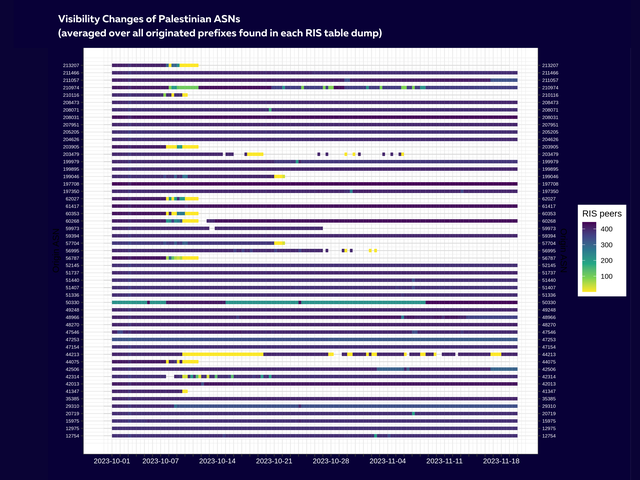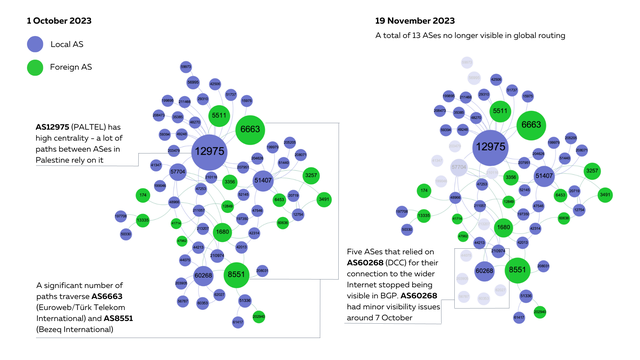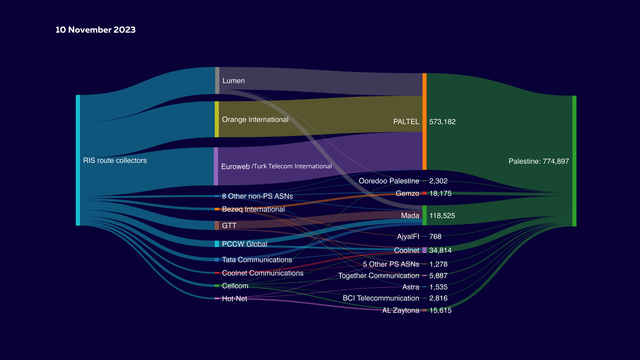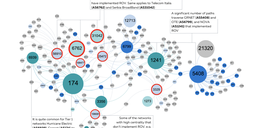What does Internet routing data tell us about how the Internet in Palestine has fared since the outbreak of war in October.
The war in Palestine continues to have a devastating impact on the local population and vital infrastructure in and around the Gaza Strip. As we are reminded time and time again, the Internet is a vital resource under such circumstances - but according to multiple reports, Internet connectivity and traffic rates across the region continue to suffer severe disruptions.
Since early October, we've been monitoring these effects as seen in the BGP data we collect via our Routing Information Service (RIS). Here, we want to share some observations about how the visibility of Palestinian networks has changed in global Internet routing over the past six weeks, and also to provide a closer look at how the Internet in Palestine connects to the rest of the world.
The view from BGP
When we use BGP data to analyse the impact events have on the Internet, we’re really focusing on understanding what paths are available for sending traffic between networks (control plane), rather than examining the actual flow of traffic along those paths (data plane). It’s all about reachability. When all paths to a network stop being visible in global routing, the network is no longer reachable over the Internet. This loss of reachability, especially when it occurs for multiple networks in a given area, is a major cause for concern in the wake of such events.
RIS is our platform for collecting BGP data. With the help of BGP peers who provide BGP data through peering sessions with our RIS Route Collectors (RRCs) across the world, RIS helps us to understand changes in global Internet routing over time.
The Internet in Palestine
We analysed the ASes registered in Palestine and their visibility in the global routing table through RIS peers from 1 October 2023 to 19 November 2023.
As seen in the graph below, it appears that as of around 7 October 2023, 11 of the 51 Palestinian networks began to experience disruptions. Of those, 8 are still no longer visible to the global Internet according to RIS. More networks experienced disruptions and were not seen by RIS peers after around 21 October onwards (see the graph for the full picture). Moreover, the total amount of IPv4 announced by Palestinian ASNs went down by about 6% since 1 October 2023 as seen in RIS.

Geolocation of networks is tremendously difficult and prone to errors. However, a quick web search of their company names suggests that some of the affected networks are based in the Gaza Strip. We are not sure of the ratio in terms of how many Palestinian networks are based in the Gaza Strip vs. the West Bank. Important to note that this is routing data and we only can see the reachability of the networks to the wider Internet.
Network classification of missing ASes
Zooming in on WHOIS information and APNIC AS population data for the ASes no longer seen in RIS, we identified two ASes associated with educational institutions: AS41347 (Islamic University of Gaza) and AS203479 (Al-Aqsa University). Others are operated by several different ISPs. The table below displays the AS number, name, and estimated population of Internet users (when available in the APNIC data):
| ASN | Name | AS Population | Network Type |
|---|---|---|---|
| 41347 | Islamic University of Gaza | - | Educational |
| 203479 | Al-Aqsa University | - | Educational |
| 199046 | JETNET | 56,207 | ISP |
| 57704 | SpeedClick | 43,024 | ISP |
| 203905,62027,60353 | DCC | 16,135 | ISP |
| 210116 | Quintiez Alfa | 15,370 | ISP |
| 56995,59973 | NetStream | 12,712 | ISP |
| 44075 | PalWifi | 3798 | ISP |
| 213207 | TechHub | 3710 | Other |
| 56787 | City Net Informatics | - | ISP |
DCC's AS60268 with an AS population of around 14K is only partially visible to RIS peers. However, the other three DCC’s downstream ASes are not visible. It is possible that DCC has infrastructure outside the Gaza region which is seen by RIS peers. Moreover, we also note that AS56787 (City Net) which is downstream to DCC’s AS60368 is also not visible since 10 October 2023.
It is important to note that the provided list of ASes experiencing outages is not exhaustive. Instances where ASes have no reachable prefixes in the routing table indicate inability for other ASes to establish communication with them. Importantly, even if the path to an AS exists, infrastructure damage may render routers of these networks inaccessible, preventing subscribers of these networks from having network connectivity.
How does Palestine connect to the world?
Palestine to Palestine
RIS gives us a certain view of the paths that networks in a country use to connect with each other and the wider Internet. When looking at which networks appear along those paths, we see that some show up much more frequently than others, indicating that they play a more important or central role in routing for the relevant country.
To measure this notion of 'centrality' in relation to the interconnectivity landscape in Palestine, we employed the AS Hegemony methodology that assigns each AS a 'hegemony value' - ranging from 0 to 1 - based on what average fraction of paths between networks in a chosen country cross that network. Networks with a value closer to one are more central, meaning more networks in the country in question are dependent on them for their interconnectivity.
The plot below gives the interconnectivity ‘map’ as of 1 October in Palestine with each node representing an AS. Purple nodes are the Palestinian ASes and the green nodes are ASes belonging to foreign countries. The larger the node, the higher its hegemony value.
As we see, a large fraction of paths between networks in Palestine pass through AS12975 (Palestine Telecommunications Company) represented by the large 'purple' node. The ASes that disappeared from the routing tables after the conflict unfolded on 7 October and are no longer visible as of 19 November are shown on the right side of the image below and marked in a faded colour.

Palestine to the rest of the world
We also examined how Palestine connects to the rest of the world from the IP networks perspective. We’ve looked at the routes collected by RIS for IP networks in each country and identified the last foreign and first domestic network encountered in these paths. This gives us an overview of which operators provide international connectivity.
The following figures look at how Palestinian networks are reached through the large Tier 1 transit providers as of 10 November 2023. They’re based on data that takes into account both the number of occurrences of each network pair, as well as the total size of the unique IPv4 address space routed via each pair. The organisations listed on the right are entry points to Palestine’s IPv4 space. This includes both addresses held by the organisation itself as well as customers that operate their own networks. The numbers refer to the total number of IPv4 addresses reached via this connection, and are therefore an indication of how many end users are served. As a result of multihoming, some IP networks may be reached via more than one entry point. The same is also true for the connections on the other end, between international and domestic networks. Only the top 10 transit providers and domestic providers are named; the rest are grouped into the category “Other PS ASNs”.
Israeli networks Bezeq international, Coolnet Communications and Hot-Net are indeed instrumental in connecting a number of Palestinian ASNs, but by far the largest amount of users in Palestine connect (directly or indirectly) to the rest of the world via Paltel which relies on Orange, Euroweb and Lumen for connectivity.
It's important to note that in this data, we can only see logical interdependency that doesn’t account for infrastructure dependency (IL backbones and fibre connections). In other words, we detect connections on the level of the Internet protocols - the data provides no insight into physical connectivity.

Conclusion
The current situation with the Internet in the Gaza region is dynamic, and there's ongoing uncertainty about the extent of the network outage. The RIS dataset reveals ASes that aren't visible to our peers, likely indicating entities operating solely within Gaza. Some ASes, like PALTEL (AS12975), are seen by RIS peers connected in BGP data, but they've reported a complete service outage in Gaza due to depleted energy sources. Despite potential undercounting of connectivity, these insights remain crucial for understanding the region's connectivity from a global Internet perspective.







Comments 0
Comments are disabled on articles published more than a year ago. If you'd like to inform us of any issues, please reach out to us via the contact form here.